The leafy green Amaranthus hybridus (known as ẹfọ tẹtẹ, Nigerian spinach) is one vegetable I really think the potential needs to be improved; and I strongly believe this can be done, with the plant’s special attributes.
A cheap nature and an unusually high, wide-range nutrient profile enables the green form good source of nutritious food for many households in Nigeria (see Tab. 1 & 3 for phytochemical composition of A. hybridus and other Amaranthus species).
The leafy vegetable taking just 4-5 weeks from sowing to harvest ensures it serves as consistent food and income source to farming/poor households.
However, with market dynamics today, population projection and economic indicators, the way ẹfọ tẹtẹ grows or how we grow it has to change. There is still a huge demand-supply gap for the vegetable in the country.
Also, population is growing exponentially where, with widening inequality gap and an absence of safety net, more than half the nation’s populace is expected to fall under extreme hunger and poverty levels in the future.
Thus, an elevated number of hungry and poor with severely battered purchasing power to take on frequently occurring food inflation would drive high demand for cheaper foods and reliance on quick-money generating livelihood -as amaranthus and its production.
Hence a new, greater dependence on the green vegetable in focus coupled with the current unsatisfied demand deficit for it would mean the crop’s one-month (and a week) maturity period will not be enough in the unfolding times.
Table 1
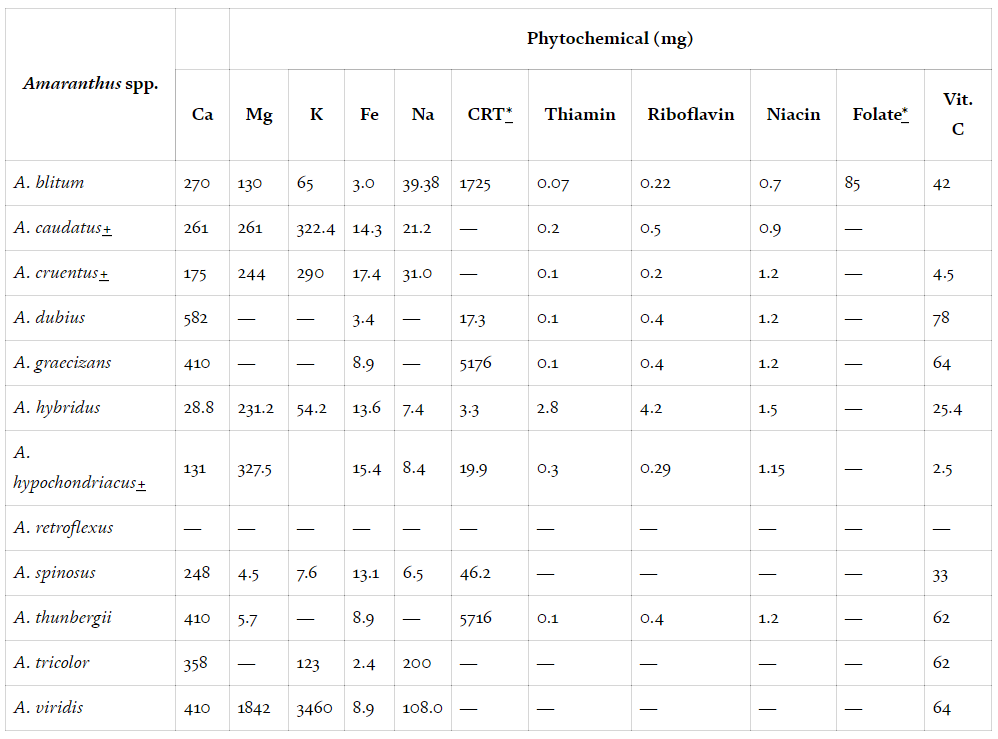
Value of Amaranthus [L.] Species in Nigeria.
Ogwu, M.C. 2020
Fortunately, the Nigerian spinach has quite a number of qualities that can be manipulated/utilised to prepare for the impending reality:
The crop belongs to a rare group of plant species with C4-photosynthesis pathway. It can bear temperature threshold beyond its normal range up to�40°C. Having broad, ovate leaves arranged alternately at intervals on the stem and being drought-tolerant are some of the good features.
What does this mean? What advantages do they give?
- C4 Photosynthesis:
The C4-pathway (Hatch-Slack Pathway) is a carbon fixation mechanism that enables efficient capture and use of CO2, with maximum carbon extraction, for sugar and other bio-molecules formation.
This is an upgrade by some plants to remedy reduced photosynthesis from C02 and water loss to photorespiration and transpiration respectively of a less efficient pathway, the C3 Calvin Cycle (CCC).
In the CCC, photosynthetic activity is limited with the enzyme (Rubisco) responsible for C02-fixing provided with oxygenated environment instead, where oxygen is being fixed partly alongside C02 rather than C02 solely, which reduces C02 assimilation and enables its loss to photorespiration.
6CO2 + 6H2O + sunlight energy → C6H12O6 + 6O2 (reaction of carbon dioxide, water & light yielding carbohydrate and oxygen)The Hatch-Slack pathway, otherwise, rectifies this problem providing a high level C02 condition with carboxylation and decarboxylation reactions in the mesophyll and bundle sheath cells in this order and with a controlled-stomata opening limiting photorespiration and transpiration (see Fig. 1).
The result is a higher C02 concentration and reduced water loss which helps in faster formation of more sugar and biomolecules.
Figure 1

Lara MV & Adreo CS (2011)
Diagram detailing two distinct reactions of the C4-pathway -one (at the top) for C02 assimilation and the other (below) for C02 fixation. This is that a non-rubisco enzyme (PEPC) not susceptible to oxygenation is the one at the site where C02 assimilation and photorespiration occur. Rather, the carbon-fixing rubisco susceptible to oxygenation is in the bundle sheath cell where it comes in contact only with C02 product from the mesophyll cells to form sugar. Also, a 3-carbon compound refixed into the mesophyll cell ensures for optimal carbon use and a continuous C02 generation process.
- Leaf shape, arrangement & content
Another benefit is that the leafy green Amaranthus having a wide leaf surface area, with dense chloroplast presence (containing numerous chlorophyll cells), and the leaves arranged alternately to fill void enable maximum light interception, absorption and use.
Utilising this understanding could amount to efficient energy use and its conversion to calorie and nutrient packed foods.
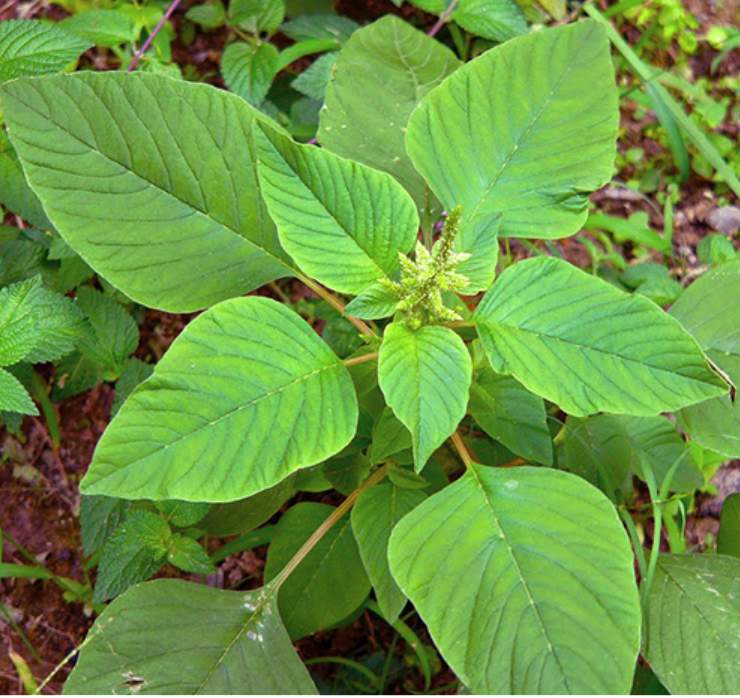
Aerial view of Amaranthus with leaves arranged filling spaces around the stem which reduces incidence of sunlight radiation loss to the environment.
Credit: Garden Hunt
- Temperature
Elevated temperature serves to favour rapid germination and increased photosynthesis. For instance, A. hybridus reaches peak germination between 30°C & 35°C and A. cruentus species in the same genus has an almost similar peak at 25°C to 30°C (see Fig. 2 for other species of Amaranthus).
The species A. caudatus has been found to undergo optimum photosynthesis at 40°C. A. hybridus, A. hybridus var. cruentus, A. tricolor, A. hypochondriacus & A. thunbergii, all have been understood, in a study by Modi (2007), to accumulate highest biomass at 27°C with a continued high accumulation at 33°C although not as much as at 27°C (see Fig. 3).
Also, as general for almost all plants, growth tallies temperature rises until a certain level (see Fig. 4). Therefore, since A. hybridus can tolerate temperature up to 40°C, growth would linear temperature increase until 30°C and a little bit above where temperature becomes harmful as seen in germination and biomass accumulation.
Growing A. hybridus in the best temperature conditions that favour maximum development and growth would amount to early maturity, higher yield for the crop.
Figure 2
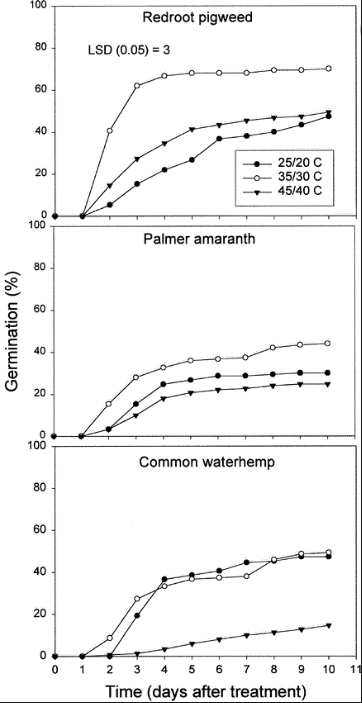
Guo, P. & Al-Khatib, K. 2003
A graphical representation of germination rate against different temperature range (25/20°C, 35/30°C & 45/40°C) for three amaranth species, Redroot Pigweed (A. retroflexus), Palmer Amaranth (A. palmeri) & Common waterhemp (A. rudis). Germination peaked for all at 35/30°C although common Waterhemp saw more germination at 25/20°C in days 4-7 but it began seeing more at former temp at 9 & 10 days.
Figure 3
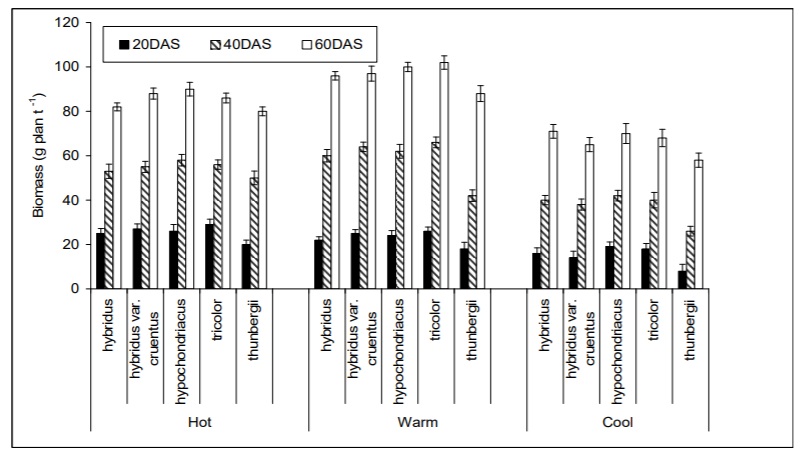
Amaranthus species biomass accumulation respective to temperature -hot (33/27°C day/night), warm (27/21°C day/night) and cool (21/15°C day/night) in 20, 40 & 60 days after sowing (DAS). Accumulation peaked at warm temperature and continued at higher degrees marking but decreased marginally as photosynthesis reaches optimum to allow for more accumulation but with enzymes being stressed, and denatured at 40°C.
Figure 4: Temperature extremes: effects on plant growth and development
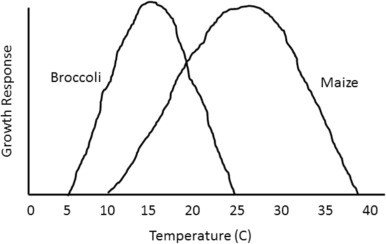
Hartfield JL, Prueger JH (2015)
How do we best make use of the positives we know about the crop; how do we simulate these conditions?
Since we know A. hybridus (inferring directly, qualities from it and from genera in the same species informing A. hydridus’ similar capabilities) is equipped for utmost light/C02 capture and use, efficient photosynthesis and to perform well at high temperature [germination (at 25-35°C), development and growth (at 30-35°C), photosynthesis and biomass accumulation (at 30-40°C)]
We can simulate these conditions -providing more C02, light at prolonged period and temperature at required range -to boost photosynthesis, biomolecules formation, maturity and get the best of A. hybridus.
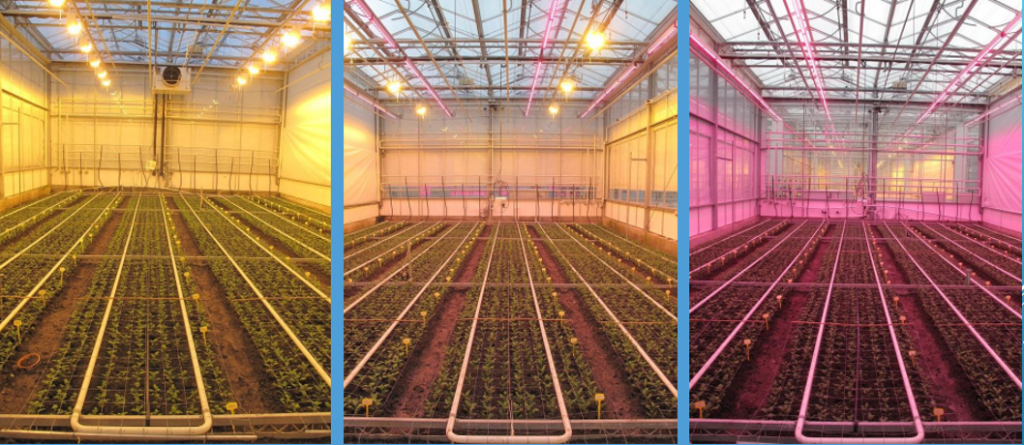
Firstly, to supply required light on extended period, Nigerian spinach can be grown in a greenhouse equipped with high pressure sodium (HPS) lights where it supplements daily light losses and increases light available to the crop (and in the night) for photosynthesis.
The Nigerian A. cruentus, for instance, which usually has longer vegetative period, on being exposed to extended daylight length has been observed to flower early.
The equivalent of the HPS is the familiar bright halogen lamps. However, the HPS has demerits. It does not provide light in the precise required spectrum of the photosynthetic active radiation (PAR) wavelengths, needed for photosynthesis.
It instead provides light in the visible light spectrum (VLS) encompassing all aspects of PAR, in which some wavelengths happen to inhibit growth -for instance, yellow waveband has been known to stress plants and studies have proved plants doing healthier with its removal in the greenhouse.

Nonetheless, instead of using a glasshouse mounted with HPS allowing for VLS, a photo-selective/screen film -one that screens light rays to required wavelengths in the PAR spectrum -can be used.
Alternatively, as scientists have found red wavelength of the PAR spectrum aids vegetative growth (which A. hybridus is grown for its leaves and where this would be important) and a mixture of the latter with blue wavelength catalyses quick flower growth (one which we desire as it enables quick vegetative period and early maturity), a greenhouse equipped with blue and red-lights radiating LEDs (light emitting diodes), scheduled for different intensities and routines, can be used to supply these wave bands.
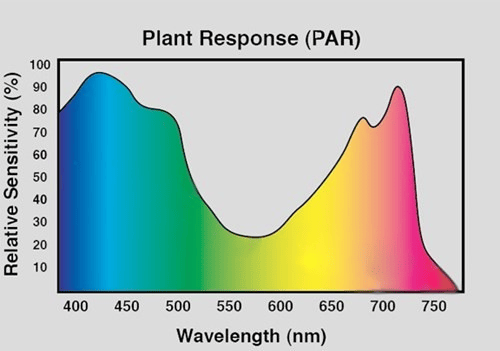
Overall, in the cause of raising light exposure to increase photosynthesis, care must be taken to not overburden the crop with light so as to prevent light toxicity and not push photoperiodic length disrupting important physiological functions and changes.
In addition, while supplying needed light spectrum, we should be cautious not to cut out other light spectrum important to plant, as violet light spectrum of the VLS, for illustration, has been discovered to increase antioxidant, organoleptic and phytochemical properties in leaves and fruits -and in this case, a covered greenhouse installed with HPS and LED can be used or a glasshouse with LED.
NB –Greenhouse is a general structure that habours light energy and simulates conducive conditions for plant growth -it could be exposed covered with glass or film to take in sunlight, or unexposed and mounted with artificial light sources -LED and/or HPS.
Secondly, to provide a high C02 concentration condition, clean fuel can be burnt in close proximity to the greenhouse and via a pipe connector to supply constant rich C02 raising the productivity of the rubisco enzyme and biomolecules formation in the mesophyll cells.
Commonly used fuel is the organic compound propane, which burns in a reaction with oxygen to give clean by-products -C02 and water.
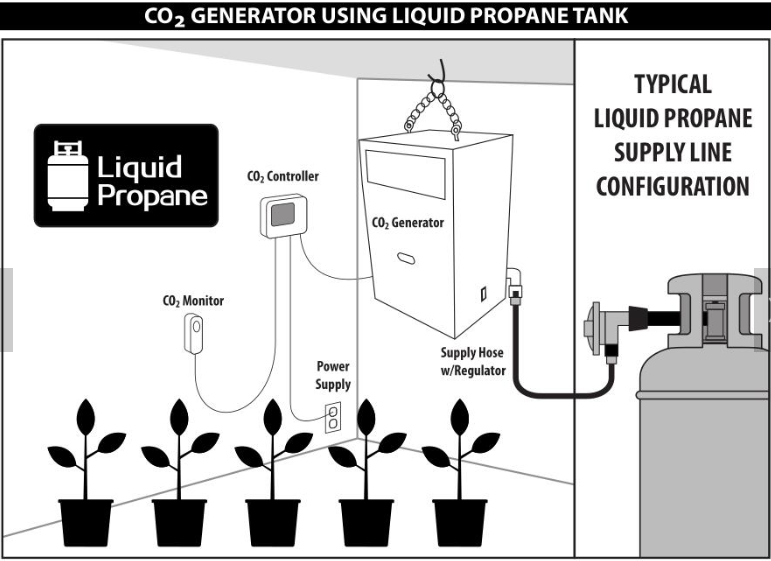
Increased C02 level enables plant to grow rapidly and bigger, even the leaves; however, this would depend on other photosynthesis factors as temperature, light and water being available at required level.
Ackerly et al (1992) in their study of C02 and temperature effects on leaf area productions in two annual plants species have shown that, for A. retroflexus, overall leaf area increased with elevated C02 and temperature at 28°C and still increased a bit at 38°C but not as much as at 28°C.
This corroborates previously highlighted point of Amaranthus species reaching growth, development and biomass accumulation peak at 30°C, still seeing gains after this optimum temp although declining.
The effect of other environmental conditions being important to seeing positive result of increased C02 was observed in a study on “Plants’ response to elevated C02” by Bazzaz & Carlson (1984), where A. retroflexus performed well under ambient, independent C02 and soil moisture conditions than in an increased C02 but competitive environment for photosynthesis inputs with three other plant species.
Thirdly, considering temperature range that positively affects A. hybridus’ growth, development, photosynthesis and biomass accumulation, glasshouse can help reach the required temp level.
The glasshouse functions to absorb light of shorter wavelengths from the surroundings and re-radiate them in longer wavelengths where they become warmer and thus raise temperature in the glasshouse.
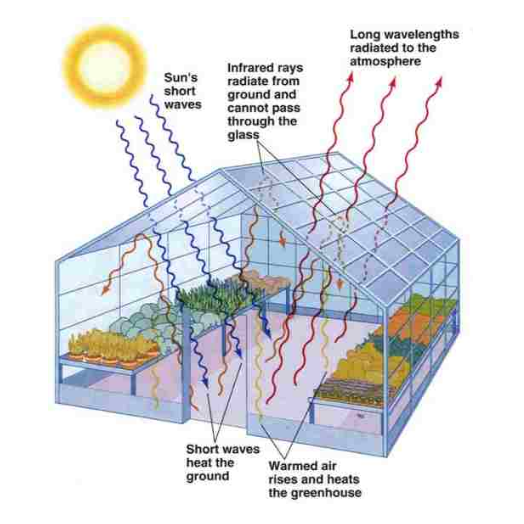
Pictorial illustration of how required high temp is created in the glasshouse. Short wavelength radiations from the sun enter the glasshouse and are absorbed by the ground, plants and every object in the glasshouse and are then re-fluoresced to long wavelengths that are warmer where most of them are trapped within the environment and warm up the glasshouse.
Moreover -even when unexposed greenhouse LED-equipped is used -C02 from the pipe connector can help bolster greenhouse temperature as reaction yielding C02 gives off heat -an exothermic reaction.
A thermostat can be installed to check and regulate temperature, as extreme temperature at/or above 40°C has been discovered to impair amaranths and -as C02 emits heat, indirectly -drive transpiration.
Although amaranth species are known to resist extreme temperature by wilting and regrowing back when temperature is right but, wilting period takes off plant’s life cycle with a resultant delay in maturity.
Also, temperature has a differing effect on amaranths’ leaf content for instance, a study by Modi (ibid) on temperature effect and age on leaf content of 5 different amaranth species shows hot temperature (33°C) reduced leaf protein content but with significantly high iron and calcium content (see Fig. 5 & Tab. 2).
This informs that there needs to be a delicate balance of temperature as temperature 21°C gave highest leaf protein content and with warm temperature at 27°C yielding moderate iron, calcium and protein contents.
Even, findings from this study helps buttress reasons for early maturing cultivar desired as the lesser the plant’s age, the higher the nutrient content level.
Nonetheless, while transpiration appears to be damaging and with amaranths having evolved feedback mechanism regulating stomata opening to reduce transpiration and, hence, photosynthesize at high temperature and transpiration, nevertheless, there seems to be a strong relationship between reduced moisture level and dry matter presence in leaves (see Tab. 3 -A. hybridus has more proximate composition with reduced moisture content, similar for other Amaranthus species too).
The positive here is that lesser volume of water could be used for production while it amounts to more dry matter in edible parts (leaf and shoot) of A. hybridus.
Figure 5
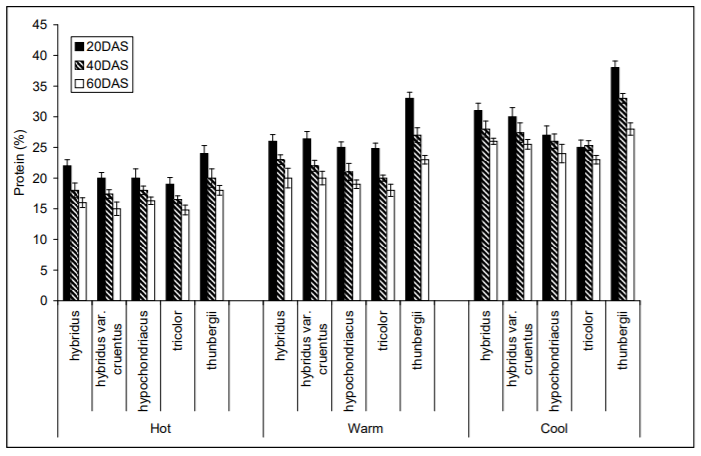
Leaf protein content of five Amaranthus species raised in different temp -hot (33/27°C day/night), warm (27/21°C day/night) and cool (21/15°C day/night) -and harvested at 20, 40, & 60 DAS, respectively.
Table 2
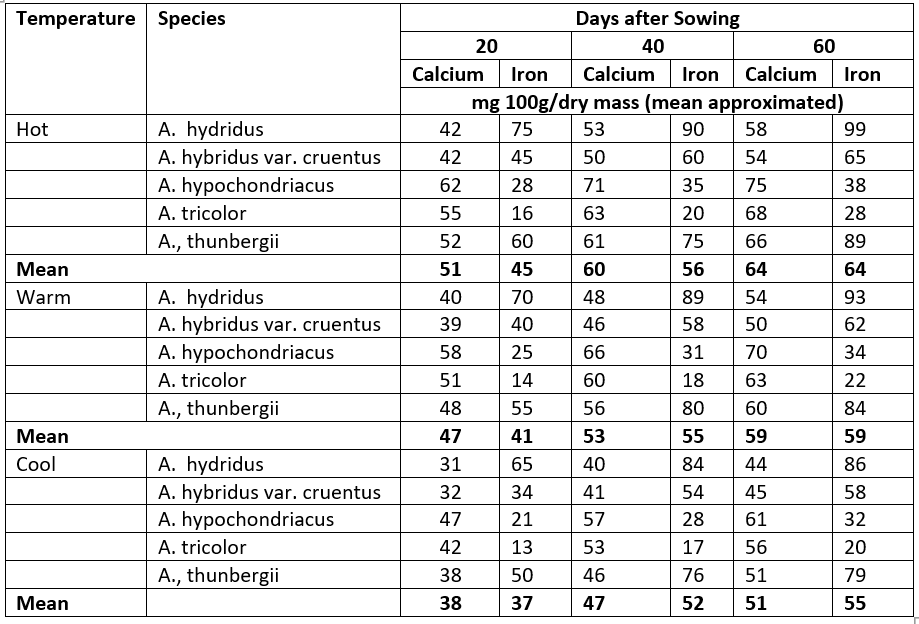
Calcium and iron content in leaves of five different Amaranth spp grown under hot (33/27°C day/night), warm (27/21°C day/night) and cool (21/15°C day/night) conditions and harvested at 20, 40, & 60 DAS
Table 3
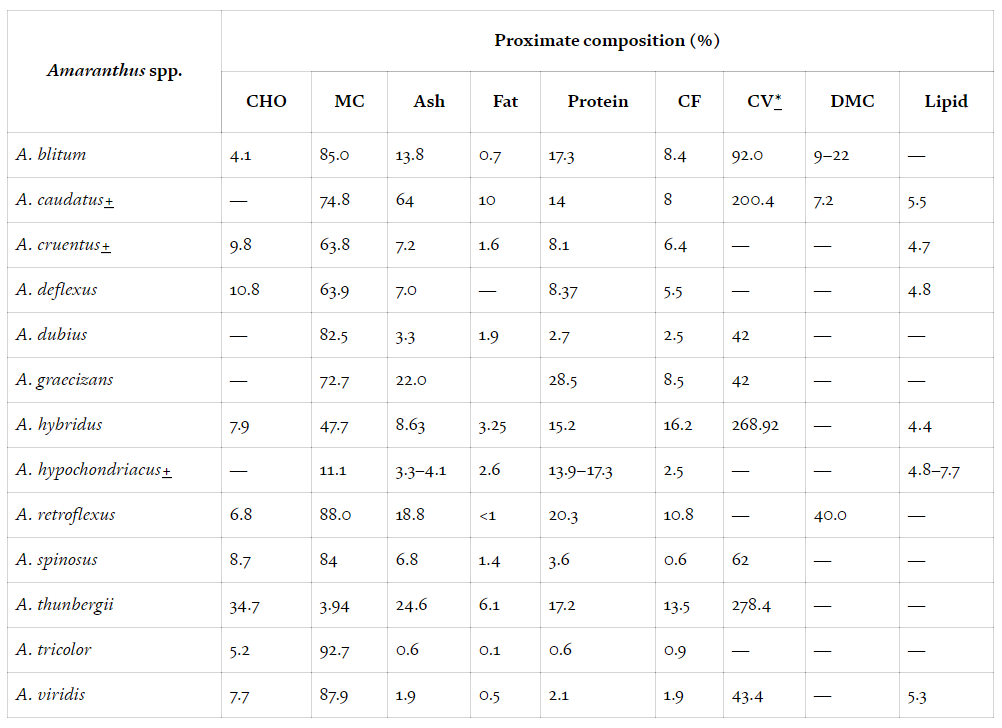
Ogwu, M.C. (ibid)
In Conclusion
The expectation is to see an early maturing ẹfọ tẹtẹ in at most 3 weeks with beneficial, healthy properties when conditions as elevated C02 level, required high temperature range and exposure to required light wavebands are delivered to maximise the advantages of C4 photosynthesis pathway, high temperature tolerance and leaf composition, shape and arrangement adapted to efficient light use and conversion.
But, of course, there is a realisation that the whole procedure of reaching an early maturing and nutrient rich A. hybridus may not necessarily be easy to achieve or may not turn out as expected since ability of A. hybridus to make best use of the proposed simulated environment is not being inferred of a sole known capability of A. hybridus, but also of other species within the same genus Amaranthus.
However, there is still a high chance of the assumption coming out positive with the simulated conditions, after all amaranth species available today have similar traits, a product of undirected or intentional breeding among the species.
For example, the A. hybridus has traits of A. viridis while the latter has of A. spinosus, with an interbreeding -according to researchers -between A. viridis and A. spinosus said to have yielded A. lividus. �
Nonetheless, the success of this idea boils down to how feasible it is, how we are able to put it to practice. Also, of paramount concern is whether crop bred in the described simulated conditions will develop fully to be mature for consumption, whether -and when it involves hydroponics -it would be safe for consumption.
Lastly, growing A. hybridus (and possibly other amaranth species) in these proposed conditions will serve to conserve increasingly stressed resources -land, water -for production and with reduced incidence of pollution since the crop is grown with lesser water and is rather being optimised to give more yield and mature early under similar conditions it is being grown than putting more land under cultivation generating more greenhouse gases.
In addition, the plant using lower levels of nitrogen (as fewer nitrogen are supplied to the rubisco enzyme in the leaf cells for photosynthesis compared to C3 plants) for growth would help limit fertiliser pollution.
